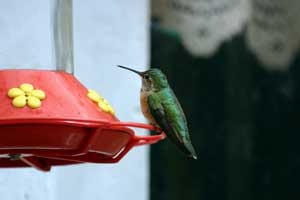The Audubon Society estimates that in the United States and Canada, as many as 1 billion birds die each year due to collisions with glass. Collisions that don't end in fatalities often leave birds temporarily stunned and vulnerable to predators, or worse, seriously injured and subject to a slow, painful death. To help keep your backyard birds safe, follow these tips for minimizing the risk of bird strikes to your doors and windows.
It's usually only a small percentage of a home's windows or doors that draw the majority of bird strikes. Observe the habits of the birds in your yard to determine which windows may pose the highest risk for strike occurrences. Look closely at extra large windows, north or south facing windows, windows near feeders, windows that face large amounts of trees, and windows in the way of obvious flight paths.
The primary cause of birds colliding with glass is due to reflection. The angle of the glass in most doors and windows creates a habitat illusion by reflecting sky and trees. When birds become confused or startled, they either attempt to take to the "sky" or rush for cover in the "trees" and smash head on into your windows.
There are several strategies you can employ to eliminate this habitat illusion without blocking out sunlight or compromising your view.
Shades and Blinds: Light colored shades, drapes or sheers work best to reduce the reflective properties of glass while letting light in and retaining your outdoor views. If you have blinds already, keep them slightly closed to reduce reflections.
Screens or Shade-cloths: Shade screens or shade cloths are inexpensive and available at most hardware stores. These are usually made from a plastic or cloth mesh that makes your window visible from the bird's perspective, but allows light to come through and allows you to see through to the outside.
Whitewashing: Whitewashing windows is one effective method for reducing glass reflections. This is especially important during migratory seasons. Fake snow works well as a temporary solution; it is fun for children to apply and can be easily removed when the risk of birds strikes diminishes.
Transparent Films: Collidescape is a transparent film designed for commercial and retail advertising on glass. It adheres to the exterior of windows and reduces reflection, without blocking the light or the view. https://www.collidescape.org/

Objects or ornaments hanging in the windows will reduce the reflection by breaking it up. They work better when placed in front of the outside of windows, especially with double paned windows that are hard for birds to see through.
Decals or Crystals: Hanging decals or silhouettes of predatory birds (no more than 10 inches apart) will also help to steer birds away from windows. Crystals and sun catchers are also attractive and effective. Enlist the help of kids and hang colorful beads, buttons, ribbons or feathers on strings or strips of cloth. Place them within one to two inches apart from each other for the best effect. Keep houseplants away from windows as they can appear like trees.
Netting can be stretched tightly across windows to create a trampoline effect should birds accidentally fly into it. Netting designed especially for this purpose should be used and product directions followed carefully in order to minimize the potential of birds getting tangled and injured.
Over 400 species of birds migrate at night. They can be attracted to artificial light and become trapped and confused, most often during inclement weather. Try to keep artificial lights to a minimum at night, especially during migratory seasons.
If you feed birds, make sure you keep feeders at least 30 feet away from windows or doors. Birds are easily startled at feeders and may fly for safety toward what is really a reflection.
Be aware of windows where there is a clear view through to another window to the outside. From a bird's point of view, this may seem like a flight path. Shade at least one window or close the door to a room to break the view.
If you find a stunned or injured bird, place it in a warm, ventilated box in a quiet area safe from cats or other predators until it has a chance to recover. If the bird has suffered a serious injury, consult with a veterinarian or licensed wildlife rehabilitation center. Make sure to use gloves when touching the bird and wash your hands thoroughly afterwards.
I use those little glow in the dark star stickers, I put them on the outside of my windows. You can place as many as you like. It doesn't obscure our view and the birds can see them.